See also
- Wow-Wow sauce
- Walnut soup – Soup with walnuts as a main ingredient
Pickled walnuts are a traditional English pickle, made from walnuts. [1] They are considered a suitable accompaniment for a dish of cold turkey or ham, as well as blue cheese. [2] There is a reference to "a mutton chop and a pickled walnut" in The Pickwick Papers by Charles Dickens and a mention in Evelyn Waugh’s Brideshead Revisited . [3] [4]
The process for preparing pickled walnuts takes a little more than a week. The green walnuts are brined before they will be pickled. The brine time helps with preservation and removes some of the bitterness in the unripe walnuts. [2]
Pickled walnuts have been a delicacy in England since at least the early 18th century. They were mentioned in several literary works.
The botanist Richard Bradley describes pickled walnuts in his 1728 book The Country Housewife and Lady's Director, [5]
The beginning of this Month is the time to pickle Walnuts, for then the Walnuts have not began to shell, and moreover are not so bitter nor hollow as they will be afterwards; they will now be full flesh'd, and you will have no Loss. The following Method I learnt from Mr. Foord, a curious Gentleman of Buckingham, and has been experienced to be the best way. There is one thing indeed which must be regarded in this Pickle, which is, that every one does not love the Taste of Onion or Garlick; but that may be omitted as we please, only supplying the place with Ginger. [continues with actual recipe]
The Compleat Housewife (London, 1727) [6] gives a recipe for "Another Way to pickle Walnuts". They're first submerged in vinegar for around two months, then boiled in a solution of high-quality vinegar with flavourings: dill seeds, whole nutmeg, peppercorns, mace and ginger root. The walnuts and pickle boiling are poured into a crock until the mixture has cooled. The nuts are then transferred to a gallipot with a large clove-studded garlic clove, mustard seeds on top with spices, covered with vine leaves over which the pickling liquid is poured.
Pickled walnuts are still commonly eaten in England, particularly at Christmas served with an English blue cheese such as Stilton. They are also used in recipes, commonly cooked in beef dishes.
Charles Dickens in his book The Pickwick Papers , published in 1836. In Chapter 49 he writes, [4]
However, there he lay, and I have heard my uncle say, many a time, that the man said who picked him up that he was smiling as merrily as if he had tumbled out for a treat, and that after they had bled him, the first faint glimmerings of returning animation, were his jumping up in bed, bursting out into a loud laugh, kissing the young woman who held the basin, and demanding a mutton chop and a pickled walnut. He was very fond of pickled walnuts, gentlemen. He said he always found that, taken without vinegar, they relished the beer.
Pickled walnuts are also mentioned in Brideshead Revisited (1945) by Evelyn Waugh. [3] [7] In Book 1, Chapter 1, Waugh writes,
Presently we drove on and in another hour were hungry. We stopped at an inn, which was half farm also, and ate eggs and bacon, pickled walnuts and cheese, and drank our beer in a sunless parlour where an old clock ticked in the shadows and a cat slept by the empty grate.
Pickled walnuts are made from the fruit of both common walnut tree varieties: Juglans regia , the Persian, royal, English or common walnut, and Juglans nigra , the black or American walnut. [2]
The first stage is to pick the walnuts whilst they are still green and before the shells have set. Most recipes say in Britain that late June is about the best time to pick them, use of rubber gloves is recommended to protect the skin. The soft walnuts are then punctured with a fork and soaked in brine (salt water) for at least ten days. The walnuts are then drained and left to dry in the air. Soaking the walnuts in brine causes a chemical reaction to take place and the walnuts turn dark brown to black in colour when exposed to sunlight. The now-black walnuts are then placed into jars and a pickling solution poured over them. This can vary from a straightforward pickling vinegar to a solution containing spices and sugar. The walnuts are sealed and then left in the jars for anywhere between five days and eight weeks depending on which recipe is followed. [2]
In food processing, brining is treating food with brine or coarse salt which preserves and seasons the food while enhancing tenderness and flavor with additions such as herbs, spices, sugar, caramel or vinegar. Meat and fish are typically brined for less than twenty-four hours while vegetables, cheeses and fruit are brined in a much longer process known as pickling. Brining is similar to marination, except that a marinade usually includes a significant amount of acid, such as vinegar or citrus juice. Brining is also similar to curing, which usually involves significantly drying the food, and is done over a much longer time period.

Ketchup or catsup is a table condiment with a sweet and sour flavor. "Ketchup" now typically refers to tomato ketchup, although early recipes for different varieties of ketchup contained mushrooms, oysters, mussels, egg whites, grapes, or walnuts, among other ingredients.

Head cheese or brawn is a meat jelly or terrine made of meat. Somewhat similar to a jellied meatloaf, it is made with flesh from the head of a calf or pig, typically set in aspic. It is usually eaten cold, at room temperature, or in a sandwich. Despite its name, the dish is not a cheese and contains no dairy products. The parts of the head used vary, and may include the tongue but do not commonly include the brain, eyes or ears. Trimmings from more commonly eaten cuts of pork and veal are often used, and sometimes the feet and heart, with gelatin added as a binder.
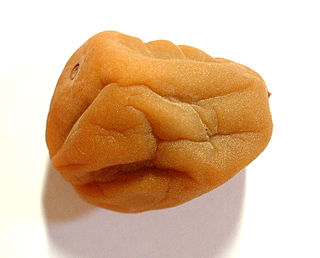
Umeboshi are pickled (brined) ume fruits common in Japan. The word umeboshi is often translated into English as 'salted Japanese plums', 'Japanese plums' or 'preserved plums'. Ume is a species of fruit-bearing tree in the genus Prunus, which is often called a "plum", but is actually more closely related to the apricot. Pickled ume which are not dried are called umezuke (梅漬け).
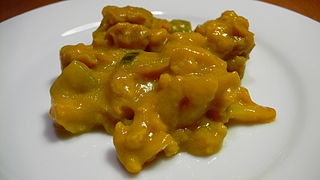
Piccalilli, or mustard pickle, is a British interpretation of South Asian pickles, a relish of chopped and pickled vegetables and spices. Regional recipes vary considerably.
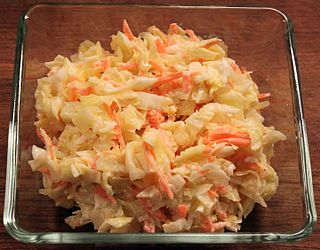
Coleslaw or cole slaw, also known simply as slaw, is a side dish consisting primarily of finely shredded raw cabbage with a salad dressing or condiment, commonly either vinaigrette or mayonnaise. This dish originated in the Netherlands in the 18th century. Coleslaw prepared with vinaigrette may benefit from the long lifespan granted by pickling.

Ratafia is a broad term used for two types of sweet alcoholic beverages, a flavouring essence whose taste resembles bitter almonds, later to a ratafia flavoured biscuit, a biscuit to be eaten along with ratafia, and later still, to a cherry variety.

Pickling is the process of preserving or extending the shelf life of food by either anaerobic fermentation in brine or immersion in vinegar. The pickling procedure typically affects the food's texture and flavor. The resulting food is called a pickle, or, if named, the name is prefaced with the word "pickled". Foods that are pickled include vegetables, fruits, mushrooms, meats, fish, dairy and eggs.
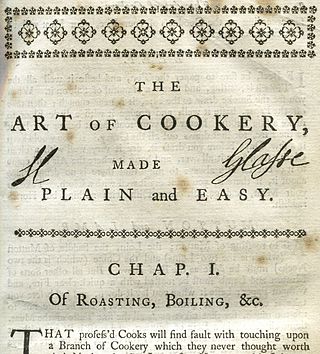
Hannah Glasse was an English cookery writer of the 18th century. Her first cookery book, The Art of Cookery Made Plain and Easy, published in 1747, became the best-selling recipe book that century. It was reprinted within its first year of publication, appeared in 20 editions in the 18th century, and continued to be published until well into the 19th century. She later wrote The Servants' Directory (1760) and The Compleat Confectioner, which was probably published in 1760; neither book was as commercially successful as her first.

The still room is a room for preparing household compounds, found in most great houses, castles or large establishments throughout Europe, dating back at least to medieval times. Stillrooms were used to make products as varied as candles, furniture polish, and soap; distillery was only one of the tasks carried out there.

Pickled eggs are typically hard-boiled eggs that are cured in vinegar or brine. As with many foods, this was originally a way to preserve the food so that it could be eaten months later. Pickled eggs have since become a favorite among many as a snack or hors d'œuvre popular in pubs, bars, and taverns, and around the world in places where beer is served.

Chicken salad is any salad with chicken as a main ingredient. Other common ingredients include mayonnaise, hard-boiled egg, celery, onion, pepper, pickles and a variety of mustards.

Scottish cuisine encompasses the cooking styles, traditions and recipes associated with Scotland. It has distinctive attributes and recipes of its own, but also shares much with other British and wider European cuisine as a result of local, regional, and continental influences — both ancient and modern.

The Compleat Housewife; or, Accomplish'd Gentlewoman's Companion is a cookery book written by Eliza Smith and first published in London in 1727. It became popular, running through 18 editions in fifty years.

Preserved lemon or lemon pickle is a condiment that is common in the cuisines of Indian subcontinent and Morocco. It was also found in 18th-century English cuisine.
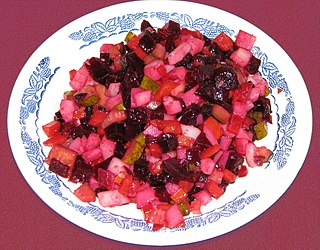
Vinegret or Russian vinaigrette is a salad in Russian cuisine which is also popular in other post-Soviet states. This type of food includes diced cooked vegetables, chopped onions, as well as sauerkraut and/or brined pickles. Other ingredients, such as green peas or beans, are sometimes also added. The naming comes from vinaigrette, which is used as a dressing. However, in spite of the name, vinegar is often omitted in modern cooking, and sunflower or other vegetable oil is just used. Some cooks add the brine from the pickled cucumbers or sauerkraut.
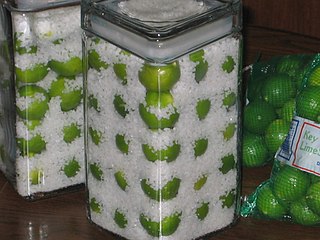
Pickled fruit refers to fruit that has been pickled. Pickling is the process of food preservation by either anaerobic fermentation in brine or immersion in vinegar. Many types of fruit are pickled. Some examples include peaches, apples, crabapples, pears, plums, grapes, currants, tomatoes and olives. Vinegar may also be prepared from fruit, such as apple cider vinegar.

Diana Astry, was an English diarist and compiler of a recipe book containing 375 recipes acquired from a number of sources including family and friends.